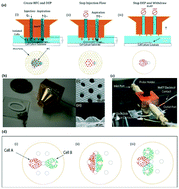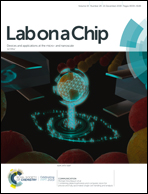Microelectrofluidic probe for sequential cell separation and patterning†
Abstract
Cell separation and patterning are of interest to several biological and medical applications including rare cell isolation and co-culture models. Numerous microfluidic devices have been used for cell separation and patterning, however, the typical closed channel configuration comes with challenges and limitations. Here, we report a dielectrophoresis (DEP) enabled microelectrofluidic probe (MeFP) for sequentially separating and patterning of mammalian cells in an open microfluidic system. The MeFP is a microfluidic probe with injection and aspiration apertures, integrated with an array of micro-hump electrodes on its tip. Aligning the MeFP parallel, and in close proximity, to a conductive substrate forms a vertical pin-plate electrode configuration that allows for an integration of DEP forces within the hydrodynamic flow confinement. Upon confining a heterogeneous cell suspension in the gap between the MeFP and the substrate, target cells are selectively captured on the micro-hump electrodes using positive DEP forces, and then deposited on the substrate in defined patterns. Characterization of the MeFP showed an increase in cell-capture efficiency when the MeFP is of a higher microfluidic multipole configuration. Separation of cancer cells from T lymphocytes was demonstrated with capture purity as high as 89.6%. Deposited patterns of isolated cells match the numerically calculated particle trajectories of the evaluated microfluidic multipoles configurations. By adjusting the flow configuration of the MeFP, we show that the patterned co-culture of two different cell types can be dynamically controlled for homotypic and heterotypic cell interaction studies. This work presents a multifunctional microfluidic tool that bio-fabricates selective multicellular patterns directly on an open substrate without the need for confined conduits.



 Please wait while we load your content...
Please wait while we load your content...